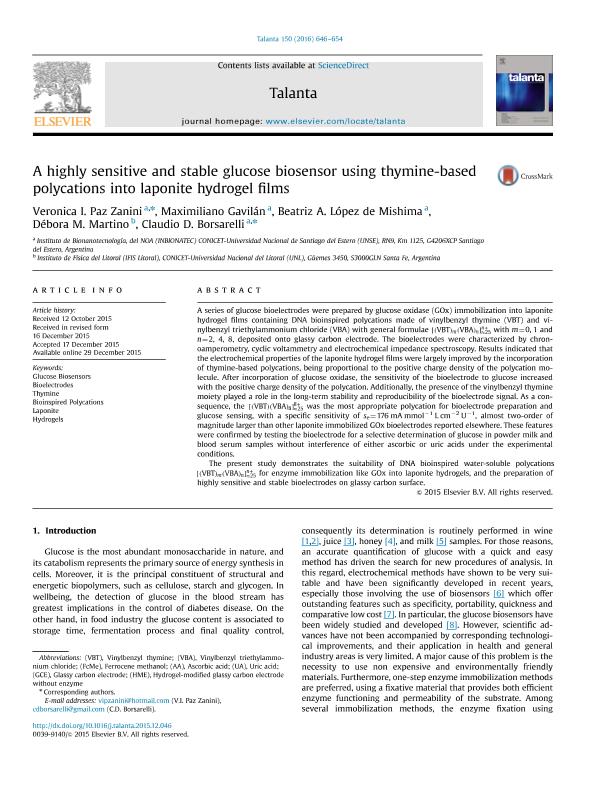Mostrar el registro sencillo del ítem
dc.contributor.author
Paz Zanini, Veronica Irene

dc.contributor.author
Gavilán Arriazu, Edgardo Maximiliano

dc.contributor.author
Lopez, Beatriz Alicia

dc.contributor.author
Martino, Debora Marcela

dc.contributor.author
Borsarelli, Claudio Darío

dc.date.available
2017-12-11T16:19:06Z
dc.date.issued
2016-04
dc.identifier.citation
Paz Zanini, Veronica Irene; Gavilán Arriazu, Edgardo Maximiliano; Lopez, Beatriz Alicia; Martino, Debora Marcela; Borsarelli, Claudio Darío; A highly sensitive and stable glucose biosensor using thymine-based polycations into laponite hydrogel films; Elsevier; Talanta; 150; 4-2016; 646-654
dc.identifier.issn
0039-9140
dc.identifier.uri
http://hdl.handle.net/11336/30132
dc.description.abstract
A series of glucose bioelectrodes were prepared by glucose oxidase (GOx) immobilization into laponite hydrogel films containing DNA bioinspired polycations made of vinylbenzyl thymine (VBT) and vinylbenzyl triethylammonium chloride (VBA) with general formulae [ ( VBT ) m ( VBA ) n ] ≈ 25 n + with m=0, 1 and n=2, 4, 8, deposited onto glassy carbon electrode. The bioelectrodes were characterized by chronoamperometry, cyclic voltammetry and electrochemical impedance spectroscopy. Results indicated that the electrochemical properties of the laponite hydrogel films were largely improved by the incorporation of thymine-based polycations, being proportional to the positive charge density of the polycation molecule. After incorporation of glucose oxidase, the sensitivity of the bioelectrode to glucose increased with the positive charge density of the polycation. Additionally, the presence of the vinylbenzyl thymine moiety played a role in the long-term stability and reproducibility of the bioelectrode signal. As a consequence, the [ ( VBT ) ( VBA ) 8 ] ≈ 25 8 + was the most appropriate polycation for bioelectrode preparation and glucose sensing, with a specific sensitivity of se=176 mA mmol−1 L cm−2 U−1, almost two-order of magnitude larger than other laponite immobilized GOx bioelectrodes reported elsewhere. These features were confirmed by testing the bioelectrode for a selective determination of glucose in powder milk and blood serum samples without interference of either ascorbic or uric acids under the experimental conditions. The present study demonstrates the suitability of DNA bioinspired water-soluble polycations [ ( VBT ) m ( VBA ) n ] ≈ 25 n + for enzyme immobilization like GOx into laponite hydrogels, and the preparation of highly sensitive and stable bioelectrodes on glassy carbon surface.
dc.format
application/pdf
dc.language.iso
eng
dc.publisher
Elsevier

dc.rights
info:eu-repo/semantics/openAccess
dc.rights.uri
https://creativecommons.org/licenses/by-nc-sa/2.5/ar/
dc.subject
Glucose Biosensors
dc.subject
Bioelectrodes
dc.subject
Thymine
dc.subject
Bioinspired Polycations
dc.subject
Laponite
dc.subject
Hydrogels
dc.subject.classification
Otras Ciencias Químicas

dc.subject.classification
Ciencias Químicas

dc.subject.classification
CIENCIAS NATURALES Y EXACTAS

dc.title
A highly sensitive and stable glucose biosensor using thymine-based polycations into laponite hydrogel films
dc.type
info:eu-repo/semantics/article
dc.type
info:ar-repo/semantics/artículo
dc.type
info:eu-repo/semantics/publishedVersion
dc.date.updated
2017-10-17T13:40:08Z
dc.journal.volume
150
dc.journal.pagination
646-654
dc.journal.pais
Países Bajos

dc.journal.ciudad
Amsterdam
dc.description.fil
Fil: Paz Zanini, Veronica Irene. Universidad Nacional de Santiago del Estero. Instituto de Bionanotecnología del Noa. Consejo Nacional de Investigaciones Científicas y Técnicas. Centro Científico Tecnológico Conicet - Tucumán. Instituto de Bionanotecnología del Noa; Argentina
dc.description.fil
Fil: Gavilán Arriazu, Edgardo Maximiliano. Universidad Nacional de Santiago del Estero. Instituto de Bionanotecnología del Noa. Consejo Nacional de Investigaciones Científicas y Técnicas. Centro Científico Tecnológico Conicet - Tucumán. Instituto de Bionanotecnología del Noa; Argentina
dc.description.fil
Fil: Lopez, Beatriz Alicia. Universidad Nacional de Santiago del Estero. Instituto de Bionanotecnología del Noa. Consejo Nacional de Investigaciones Científicas y Técnicas. Centro Científico Tecnológico Conicet - Tucumán. Instituto de Bionanotecnología del Noa; Argentina
dc.description.fil
Fil: Martino, Debora Marcela. Consejo Nacional de Investigaciones Científicas y Técnicas. Centro Científico Tecnológico Conicet - Santa Fe. Instituto de Física del Litoral. Universidad Nacional del Litoral. Instituto de Física del Litoral; Argentina
dc.description.fil
Fil: Borsarelli, Claudio Darío. Universidad Nacional de Santiago del Estero. Instituto de Bionanotecnología del Noa. Consejo Nacional de Investigaciones Científicas y Técnicas. Centro Científico Tecnológico Conicet - Tucumán. Instituto de Bionanotecnología del Noa; Argentina
dc.journal.title
Talanta

dc.relation.alternativeid
info:eu-repo/semantics/altIdentifier/url/http://www.sciencedirect.com/science/article/pii/S0039914015305749
dc.relation.alternativeid
info:eu-repo/semantics/altIdentifier/doi/http://dx.doi.org/10.1016/j.talanta.2015.12.046
Archivos asociados
